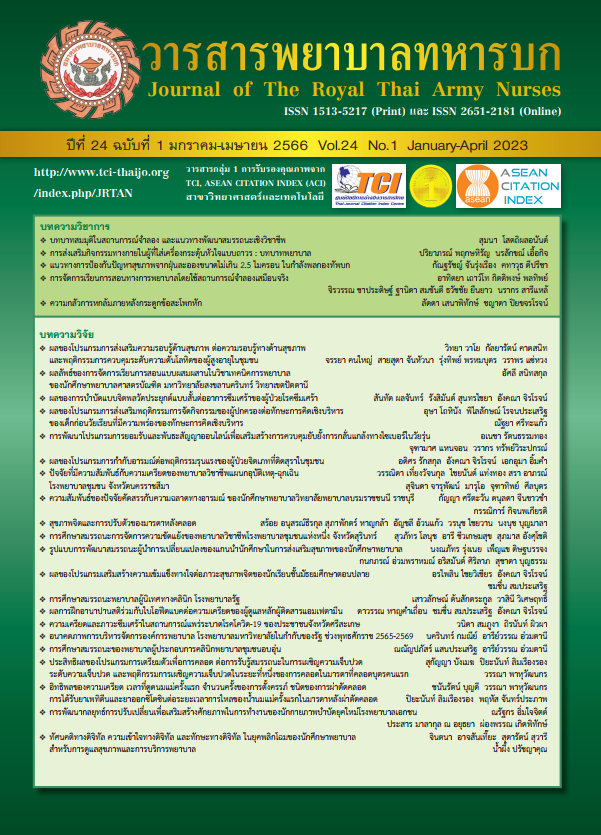Resilience Quotient, Depression and Suicidal Tendency of the New Privates, Signal Department Royal Thai Army
Keywords:
Resilience Quotient, Depression, Suicidal Tendency, PrivatesAbstract
The purpose of this research was to study the levels of the Resilience Quotient and its relation with chances of having depressive disorder and suicidal tendency in order to apply the results as a base of figuring supportive activities or schemes of improving potential of adapted ability to limit the depressive condition and suicidal tendency in 518 privates positioned in Signal Department Royal Thai Army. The data-collecting instruments used are a depression questionnaires comprising of 2 questions and 9 questions as called 2Q9Q, a suicide questionnaire comprising of 8 questions known as 8Q, and a resilience quotient questionnaire. The data were analyzed and presented in term of descriptive statistics and Pearson Product Moment Correlation Coefficient. The results showed that 54.4 percent of the privates had a normal level of resilience quotient while approximately 23.3 percent of them had a higher level of resilience quotient, and only 22.4 percent of them had a lower level of resilience quotient. The findings of depression indicate that 68.8 percent of the privates had no connection with the depressive disorder. As mentioned, there was 31.2 percent left seeming to carry this condition. There was 19.3 percent holding a low level, 10.0 percent had a medium level, and 1.9 percent carried a severe level. The outcomes of the study of committing suicide present that 57.2 percent of the privates had none of possibility to kill themselves whereas 42.8 percent of the rest tended to show little tendency of suicide. The correlation between resilience quotient and level of depression showed that the level of Resilience Quotient was inversely related to the level of depression (r = -0.337) with statistically significant (p = .01). The correlation between level of depression and suicidal tendency showed that the level of depression was directly related to the suicidal tendency, (r = -0.481) with statistically significant (p = .01)
Downloads
References
Clarke J. Resilience Bounce Back from Whatever Life Throws at You. 2nd ed. United Kingdom: Crimson Publishing;2012
Department of Mental Health. World Mental Health Day. Siamrath. Bangkok: Siamrath Publishing;2019. (in Thai)
Academic Department. Military Law. Bangkok: Sutpaisarn Publishing;2014. (in Thai)
Ministry of Public Health. Depression primary care guidelines. Bangkok: The Excellent Center for Depressive Disorder;2014. (in Thai)
Weeraarchakul W. Factors Related to Stress among Dental Student of Khonkaen University. North-Eastern Thai Journal of Neuroscience. 2014;13(3) : 11-9. (in Thai)
Department of Mental Health. Resilience Quotient. Bangkok: Mental Health Development;2016. (in Thai)
Kunnatee N. Stress and Coping Strategies of The Royal Thai Army New Privates. Journal of The Royal Thai Army Nurses. 2012;13(2) : 72-81. (in Thai)
Wissanutothin S. Clinical practice guidelines for treating persons with MDD in primary care setting. The Journal of Boromarajonani College of Nursing.2010;16(2) : 5-22. (in Thai)
Department of Mental Health. Guidebook of Depressive Disorders Surveillance and Care Provincial Level. 3rd ed. Bangkok;2014. (in Thai)
Limganjanawat S. The Effects of the ResilienceEnhancing Program on the Undergraduates of Faculty of Environment and Resource Studies, Mahidol University. Songklanakarin Journal of Humanities and Social Sciences.2016;22(2) : 149-79. (in Thai)
Downloads
Published
How to Cite
Issue
Section
License
Copyright (c) 2023 Journal of The Royal Thai Army Nurses

This work is licensed under a Creative Commons Attribution-NonCommercial-NoDerivatives 4.0 International License.
บทความหรือข้อคิดเห็นใดใดที่ปรากฏในวารสารพยาบาลทหารบกเป็นวรรณกรรมของผู้เขียน ซึ่งบรรณาธิการหรือสมาคมพยาบาลทหารบก ไม่จำเป็นต้องเห็นด้วย
บทความที่ได้รับการตีพิมพ์เป็นลิขสิทธิ์ของวารสารพยาบาลทหารบก
The ideas and opinions expressed in the Journal of The Royal Thai Army Nurses are those of the authors and not necessarily those
of the editor or Royal Thai Army Nurses Association.






